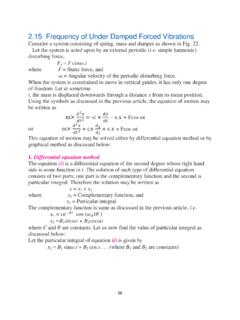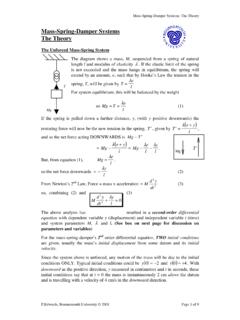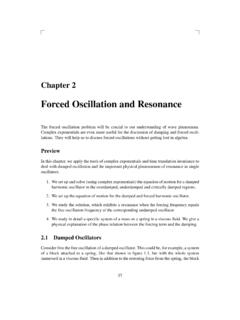Transcription of Vibration, Normal Modes, Natural Frequencies, Instability
1 S. Widnall Dynamics Fall 2009 Version Lecture L19 - Vibration, Normal Modes, Natural Frequencies, Instability Vibration, Instability An important class of problems in dynamics concerns the free vibrations of systems. (The concept of free vibrations is important; this means that although an outside agent may have participated in causing an initial displacement or velocity or both of the system, the outside agent plays no further role, and the subsequent motion depends only upon the inherent properties of the system. This is in contrast to forced motion in which the system is continually driven by an external force.) We shall consider only undamped systems for which the total energy is conserved and for which the frequencies of oscillation are real. This forms the basis of the approach to more complex studies for forced motion of damped systems. We saw in Lecture 13, that the free vibration of a mass-spring system could be described as an oscillatory interchange between the kinetic and potential energy, and that we could determine the Natural frequency of oscillation by equating the maximum value of these two quantities.
2 (The Natural frequency is the frequency at which the system will oscillate unaffected by outside forces. When we consider the oscillation of a pendulum, the gravitational force is considered to be an inherent part of the system.) The general behavior of a mass-spring system can be extended to elastic structures and systems experiencing gravitational forces, such as a pendulum. These systems can be combined to produce complex results, even for one-degree of freedom systems. We begin our discussion with the solution of a simple mass-spring system, recognizing that this is a model for more complex systems as well. 1 In the figure, a) depicts the simple mass spring system: a mass M, sliding on a frictionless plane, restrained by a spring of spring constant k such that a force F (x)= kx opposes the displacement x. (In a particular problem, the linear dependence of the force on x may be an approximation for small x.) In order to get a solution, the initial displacement and initial velocity must be specified.
3 Common formulations are: x(0) = 0, and dx (0) = V0 (The mass responds to an initial impulse.); or x(0) = X0 and dx (0) = 0 (The mass is given dt dt an initial displacement .). The general formulation is some combination of these initial conditions. From Newton s law, we obtain the governing differential equation d2x m = kx (1)dt2 with x(0) = X0, and dx (0) = The solution is of the general form, x(t)= Re(Aei t), where, at this point in the analysis, both A and are unknown. That is, we assume a solution in which both A and are unknown, and later when the solution is found and boundary conditions are considered, we will end up taking the real part of the expression. Depending upon whether A is purely real, purely imaginary, or some combination, we will in general get oscillatory behavior involving sin s and cos s since ei t = cos t + i sin t. For a system without damping, 2 = Real(K) (K being some combination of system parameters.), so that = K.
4 For undamped systems, these two values of , are redundant; only one need be taken. To solve the differential equation, equation(1) is rewritten d2x m + kx = 0. (2)dt2 With the assumed form of solution, this becomes 2 mx(t)+ kx(t)= 0 = x(t) ( 2 m + k) (3) kSince x = x(t), for a valid solution, we require = m . This approach works as well for systems b) and c). These two systems are pendulums restrained by torsion springs, which for small angles ( or ) produce a restoring torque proportional to the angular departure from equilibrium. Consider system b). Its equilibrium position is = 0. The restoring torque from the spring is Ts = . The restoring torque from gravity is Tg = mgLsin which for small angles becomes Tg = mgL . Writing Newton s law in a form appropriate for pendular motion, we obtain d2 1 mL =(Tg + Ts) (4)dt2 LWe assume a form of solution, (t)= Ae(i t), and rewrite the equation as before, moving all terms to the left-hand side.
5 ML 2 + 1 L(mg L + ) (t) = 0. (5) Therefore for a solution we require = mgL + mL2 (6) 2 Examining this result, we see that the combination of the spring and gravity acts to increase the Natural frequency of the oscillation. Also if there is no spring, = 0, and the result becomes just the frequency of a pendulum = Lg . System c) is perhaps a bit more interesting. In this case, we use the small angle . We take the equilibrium position of the spring to be = 0 so that the restoring torque due to the spring is again Ts = . But now in this case, we are expanding the gravitational potential about the point = 0. Since this is an unstable equilibrium point, this gives the restoring ( it doesn t restore, it keeps going! ) torque due to gravity as Tg = mgLsin or for small , Tg = mgL . Writing the governing equation for this case, we obtain 1 mL 2 +( mgL + ) (t)= 0. (7)L Therefore for a solution we require = mgL + (8)mL2 mgL In this case, there is a critical value of for which = 0.
6 On either side of this point, we have = mL2 , which gives real for > mgL, and imag for < mgL. Since we have assumed (t)= ei t , a real will produce oscillatory motion; an imaginary will produce exponentially diverging, or unstable, motions. We say that the pendulum for less than the critical value, = mgL, is unstable. Vibration of Multi-Degree of Freedom Systems We begin our treatment of systems with multiple degrees of freedom, by considering a two degree of freedom system. This system contains the essential features of multi-degree of freedom systems. Consider the two two-mass, two-spring systems shown in the figure. 3 In this case, there are two independent variables, x1(t) and x2(t); their motion is not independent, but is coupled by their attachments to the springs k1, k2 and for system b), k3. The sketch shows the forces Fi acting on the masses as a result of the extension of the spring; these of are equal and opposite at the ends of the springs.
7 We consider both system a) and b). System b) is actually the simpler of the two systems because of its inherent symmetry. The governing equations can be written as for system a) d2x1 m1 = k1x1 + k2(x2 x1) (9)dt2 m2 d2x2 = k2(x2 x1) (10)dt2 for system b) d2x1 m1 = k1x1 + k2(x2 x1) (11)dt2 m2 d2x2 = k2(x2 x1) k3x2 (12)dt2 In both cases, as before, we assume a solution of the form x1(t)= X1ei t and x2(t)= X2ei t . However, as we will see, in this case, we will obtain two possible values for 2; both will be real; we will take only the positive value of itself. These will be the two vibration modes of this two degree of freedom system. These results extend to N 2 s for an N degree of freedom system. Again, we will take only the positive value of . Consider first system b). With the assumed form of solution, and rewriting all terms on the left-hand side, we obtain 2 m1X1 + k1X1 k2(X2 X1) = 0 (13) 2 m2X2 + k2(X2 X1) + k3X2 = 0 (14) This equation can be written in matric form as k1 + k2 k2 k2 k2 + k3 m1 2 0 0 m2 2 X1 X2 = 0 0.
8 (15) or k1 + k2 m1 2 k2 k2 k2 + k3 m2 2 X1 X2 = 0 0 . (16) This equation makes a very powerful statement. Since the right-hand side of both equations is zero, a condition for a solution is that the determinant of the matrix equals zero. This will give an algebraic equation with two solutions for : 1 and 2. These are the Natural frequencies of the two degree of freedom system. In the general case, they are not equal; and both x1 and x2 participate in the oscillation 4 at each frequency i. Also, as in the single degree of freedom system, the actual values of x1(t) and x2(t) dx1are determined by initial conditions; in this case 4 initial conditions are required: x1(0), x2(0), dt (0),and dx2 (0). The actual values of X1 and X2 are of less interest than the relationships between them and the dt structure of the problem. If the two masses are equal, a particularly simple form of a more general result follows from equation(16).
9 We consider this as an introduction to the more general case. The more general case will be considered shortly. k1/m + k2/m 2 k2/m X1 = 0 . (17) k2/m k2/m + k3/m 2 X2 0 We determine the two values of i ( 1 and 2) by setting the determinant equal to zero. We then substitute each value of i in turn into the matrix equation and determine for each i the coefficients X1i and X2i; only their ratio can be determined. We write the coefficients X1i and X2i as vectors, X 1 = (X11,X21) and X 2 =(X12,X22), where the subscript 1 refers to the mode associated with 1, and 2 refers to the mode associate with 2. It is a remarkable property of the solution to the governing equations that these vectors are orthogonal: the dot product of X 1 X 2 = 0 (We will follow with an example to amplify and clarify this.) Consider the simplest case of system b) with both masses equal to m and all springs of stiffness k. In this case we have 2k /m 2 k/m X1 = 0.
10 (18) k/m 2k /m 2 X2 0 Setting the determinant equal to zero gives two solutions for : 1 = k/m and 2 =3k /m. The components of the x1 and x2 motion are: X 1 = (1, 1) and X 2 =( 1, 1). This simple example gives great physical insight to the more general problem. The Natural frequency is i; the components X i = (Xi1,Xi2) are called Normal modes . Normal Modes of Multi-Degree of Freedom Systems Examining the first Normal mode , we see an oscillation in which X 1 = (1, 1) occurs at an oscillation frequency 1 = k/m. Since X 1 = (1, 1), the central spring does not deform, and the two masses oscillate, each on a single spring, thus giving a frequency = k/m. The second Normal mode has a frequency =3k /m, with X 2 =( 1, 1); thus the masses move in opposite directions, and the frequency of oscillation is increased. It can be seen by inspection that the vector X 1 and X 2 are orthogonal (their dot product is zero.) If such a system was at rest, and an initial impulse was given to one of the masses, both modes would be excited and a free oscillation would occur with each mode oscillating at its Natural frequency.















